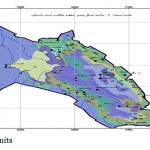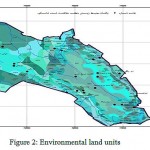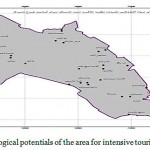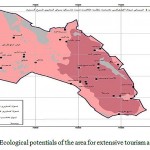How to Cite | Publication History | PlumX Article Matrix
B. Saeedpour
University of environment, Karaj, Iran. Corresponding Author E-mail: bsaeedpour@gmail.com
DOI : http://dx.doi.org/10.13005/bbra/2327
ABSTRACT: Assessment of the ecological potential in ecotourism industry is considered as an important tool for acquiring a proper tourism pattern and for avoiding possible undesirable consequences. Considering the ecological specifications of the area, in this study, the ecological potential of Shaskoh protected area was evaluated using systematic analyzing method and map overlapping which created uniform land units. A specific model for the area was determined using “Iranian model for ecotourism and protection”, and eventually the ecological potential was evaluated after comparing it with proposed land uses. Analyses were performed using ArcGIS 9.3. According to results, majority of the area of study lacks potential for intensive tourism activities and only 0.04 % of total area (24.25 ha) is suitable for category 2 of tourism activities. 11.6 % (8326.18 ha) of the area has the potential for extensive tourism activities.
KEYWORDS: Assessment of ecological potential; recreation; Shaskoh protected area
Download this article as:| Copy the following to cite this article: Saeedpour B. Assessment of the ecological potential of Shaskoh protected area for determining suitable ecotourism sites. Biotech Res Asia 2016;13(3). |
| Copy the following to cite this URL: Saeedpour B. Assessment of the ecological potential of Shaskoh protected area for determining suitable ecotourism sites. Biotech Res Asia 2016;13(3). Available from: https://www.biotech-asia.org/?p=16157 |
Introduction
Environmental potentials are considered as those environmental data suitable for improvement of economical productivity (Yazdi, 2006). Tourism industry is one of the most important human activities that got considerable attention by people throughout the world, and ecotourism is the most favorable recreational activity in its center (Mousavi, 2014). Giving information about natural environment, ecotourism is considered as a sort of activity and program in tourism industry with sustainable way of management (Zahedi, 2006). Assessment of environmental potential (ecological and socioeconomic) is considered as an evaluation of possibilities for the use of land for such purposes like agriculture, range management, forestry, parks (protection and tourism), aquaculture, military affairs, engineering and development of urban and rural areas (Makhdom, 2010). Even though tourism is known as a developing tool for betterment of socio-economical conditions with minor negative environmental impact, the environment shouldn’t be considered as the sacred lamb for economical development without taking into consideration all physical and social parameters (Gulinch, 2000). Assessment of ecological potential uses overlapping of ecologically stable layers like geographical directions, slope and topography to form uniform land units before their combing with other soils, vegetation maps and also other fluctuating parameters like climate, habitats and typical animal distribution patterns for developing a comprehensive land use units for modeling and evaluation of ecological potential in a study area. Generally, assessment of environmental potential could be defined as a proper adjustment in relation to human beings and its surrounding environment for better and sustainable use of all parts of it for promoting welfare of the society in long term. Spatial management by considering all environmental characteristics (Makhdom, 2010) and the potential of human beings and natural environments is considered as not only the existing visible capability but also as those possibly hidden ones which could be quite enormous and determined only through a precise evaluation (Hosseini Abri, 2000). According to UNESCO, Iran is rated among the 10 most touristic destinations in the world in terms of ancient civilization and numerous historical and cultural heritages together with diverse climatic conditions and among the 5 ones in terms of ecological diversity and richness in its four complete seasons together with different seas, deserts, geysers and wildlife. Moreover, ancient heritages could satisfy tourists in this Asian country (Abdollahi, 2009). Shaskoh protected area with lots of landscapes and touristic attractions is located in South Khorasan Province.
Different land uses have been classified for this area using environmental potential evaluation which is considered as a systematic evaluation method based on ecological mapping techniques. Studies show that potential assessment can help to compare all suitable land uses with choosing proper operations for land management (Giuseppe, 2012). Analyzing ecological models with help of GIS techniques, tourism development in an area is achievable (Shi, 2004). Iranian ecological models, which are designed mathematically, can be analyzed using GIS software (Jouzi, 2013). In this study, environmental potential of Shaskoh protected area has been assessed to determine intensive or extensive tourism sites in which ecological information has been gathered from the processed area using Arc GIS software and systematic analyzes.
Material and methods
Land units were determined by processing collected data from ecological resources in the area and followed by developing a specific model using the identified resources and “Iranian model for ecotourism and protection” (Makhdom, 2010). This model is a systematic analyzing method based on mapping ecological resources. Arc GIS program is used for overlapping ecological resource maps to create uniform land units with specific ecological characteristics prior to final comparisons in order to determine the area potential for ecotourism activities. Procedures of the main study are as below:
– Literature review and collecting maps (1:50000) and information on climate, water resources, geology, pedology, vegetation and land uses of the area.
– Generation of layer maps for elevation, slope and compass direction using topographical map and SRTM (Shuttle Radar Topography Mission) digital elevation model.
– Overlaying directions, slope and elevation maps for generation of preliminary and final land units with coding them.
– Overlaying the generated land units with maps of land uses and vegetation cover for generation of preliminary and final environmental units with coding them.
– Generation of ecological potential map for determining proper tourist sites with considering specific ecological instabilities of the area.
Results
Elevation classes
Elevation classes were generated by using SRTM 90m digital elevation model which shows 3 different elevation classes for the study area (Table 1). Low hills with many eroded and bare valleys together with no or shallow layers of soil and sometimes moderately deep layers with gravels considered typical of the area. In general, the majority of the study area located within the elevation class (800-1000 m).
Table1: Elevation classes
| Elevation class | Class code | Area (ha) | Area (%) |
| 800 – 1000 | 1 | 39746.24 | 55.66 |
| 1000 – 1500 | 2 | 15797.17 | 22.12 |
| 1500 – 2800 | 3 | 15871.87 | 22.22 |
| Sum | 71415.29 | 100 | |
Slope classes
Five classes of different slopes were generated using SRTM 90m digital elevation model by considering the purposes and scale of the study together with geomorphological features of the area (Table 2). According to the slope map, 50% of the study area is located within the slope class of 0-10% which could be described an almost flat area with no specific directions.
Table 2: Slope classes
| Slope class (%) | Class code | Area (ha) | Area (%) |
| 0 – 10 | 1 | 35320.03 | 49.44 |
| 10 – 20 | 2 | 10614.14 | 14.86 |
| 20 – 40 | 3 | 14082.97 | 19.71 |
| 40 – 60 | 4 | 10326.88 | 14.46 |
| > 60 | 5 | 1094.30 | 1.53 |
| Sum | 71438.31 | 100 | |
Slope direction (aspect) classes that depend on the study purposes and slope directions could be classified to either 5 (north, south, east, west and no direction) or 9 (north, northeast, northwest, south, southeast, southwest, east, west, no direction) aspects. In this study, 4 slope classes of flat (no direction, with slope of 0-10%), east, west and southwest were determined after some cartographic adjustment using filtering technique and omitting few classes due to their low extensiveness were done (Table 3).
Table 3: Slope direction classes
| Slope direction class | Class code | Area (ha) | Area (%) |
| Flat | 1 | 34873.66 | 48.80 |
| E | 2 | 1051.94 | 1.47 |
| SE | 3 | 31586.29 | 44.20 |
| W | 4 | 3947.64 | 5.52 |
| Sum | 71459.53 | 100 | |
Land units
Combining maps of elevation, slope and slope directions generated 22 different land units in the study area (Fig.1).
 |
Figure 1: Land units |
Soil type
Soil is one of the most important factors in evaluating ecological potentials. Table (4) shows those important soil factors used in potential assessment model are performed according to the Iranian classification model (Makhdom, 2010) using Pedology and soil classification map of the area.
Table 4: Classification of soil parameters
| Class | Soil texture | Soil drainage | Soil gravel (%) | Soil particles | Soil depth (cm) | Soil erosion |
| 1 | Sand | Well drained | 12-15 | Very fine | >180 | No erosion |
| 2 | Loamy sand | Moderatly well drained | 16-50 | Fine | 180-121 | Moderately low |
| 3 | Sandy loam | Somewhat poorly drained | 51-90 | Medium | 120-61 | Moderately high |
| 4 | Loamy | Poorly drained | >90 | Coarse | 60-31 | High |
| 5 | Silty loam | Very poorly drained | – | – | <30 | Very high |
| 6 | Silty | – | – | – | – | – |
| 7 | Sand clay loam | – | – | – | – | – |
| 8 | Clay loam | – | – | – | – | – |
Soil depth in Shaskoh protected area comprised of 5 different classes as shown in (table 5).
Table 5: Soil depth classification
| No | Land capability | Soil depth (cm) | Area (ha) | Area (%) |
| 1 | 6.1 | Very deep(>180) | 1222.11 | 1.72 |
| 2 | 3.5 | Deep (121-180) | 384.04 | 0.55 |
| 3 | 3.1 , 3.2 | Moderately deep (61-120) | 13399.08 | 18.77 |
| 4 | C1, C2, 8.1, 8.2, 2.2 | Shallow (31-60)
|
24688.81 | 34.57 |
| 5 | 1.1, 1.2
|
Very shallow (<30) | 31720.98 | 44.38 |
| Sum | 71415.29 | 100 | ||
Soil texture in the area is made from 4 different groups as table (6).
Table 6: Soil texture classification
| No | Land capability | Soil texture | Area (ha) | Area (%) |
| 1 | 1.2 | Sandy | 7524.46 | 10.54 |
| 2 | 1.1, 2.2, 3.1, 3.2, 8.1, 8.2, C1, C2 | Loamy sand | 62284.67 | 87.21 |
| 3 | 3.5
|
Sandy loam | 384.04 | 0.54 |
| 4 | 6.1
|
Silty clay | 1222.11 | 1.71 |
| Sum | 71415.29 | 100 | ||
Geology and earthquake
Geology is considered as one of the important factors in allocating land for ecotourism activities. Geological studies in the study area are performed by the help of geological map from Iranian geological organization. In this study, those areas with faults and possible seismic activities were not considered as suitable sites for intensive tourism activities. Based on geological maps, Karizan active fault is considered as the most important fault in the area which extends northerly from Karizan village (Saidpour, 2011).
Vegetation cover
A list of plant species in the area were prepared as canopy cover density and species diversity are known as the two most effecting factors in the assessment of ecological potential for ecotourism and protection purposes. Knowing that the plant species in the area are not appeared on the IUCN red list and that it is a rangeland with fifth priority for intensive tourism activity according to its canopy cover density, there would be no restriction for intensive tourism activities in this area with concern to its vegetation cover. Canopy cover densities were classified by considering specific growth condition of the area and Iranian category (Table 7).
Table 7: Classes of canopy cover density
| Class | Canopies cover density (%) |
| 1 | 76 – 100 |
| 2 | 51 – 75 |
| 3 | 26 – 50 |
| 4 | 0 – 25 |
Environmental land units
As mentioned above, environmental land units were generated by combining maps of preliminary land units, vegetation type and density in which 105 units with different specific characteristics were created (Fig.2).
 |
Figure 2: Environmental land units |
Climate and weather
Air temperature, relative humidity, wind speed and a number of sunny days are considered as those important climatic parameters that were used in ecotourism potential assessment based on Iranian classification model (Table 8). Such climatic parameters were collected from Ghaen synoptic station.
Table 8: Classes of climatic parameters
| Class | Ave.temp (ₒC) | Ave. relative humidity (%) | Ave. wind speed(km/h) | Sunny day per month(h/day) |
| 1 | < 18 | < 40 | 1 – 35 | < 7 |
| 2 | 18.1 – 21 | 40.1 – 60 | 36 – 60 | 8 – 15 |
| 3 | 21.1 – 24 | 60.1 – 80 | 61 – 100 | 15 |
| 4 | 24.1 – 30 | 80.1 – 100 | > 101 | – |
| 5 | > 30.1 | – | – | – |
Based on collected data from the synoptic station, the Shaskoh protectedd area with average yearly temperature of 14.5 – 22.3 (suitable for class 1 and 2 of intensive and extensive tourism activities), relative humidity of 39 % (class 1), sunny days of 137.4 day/year (11.4 h/day) (suitable for class 2 of intensive and extensive tourism activities) and average wind speed of 16 km/h (suitable for class 1 and 2 of intensive and extensive tourism activities) shows no specific limitations for such activities concerning the prevailing climatic conditions.
Wildlife
Indicator species with their habitats were determined for ecological potential assessment using their values as in table (9) (Makhdom, 2010). A comparison between the animals and different categories in this table will show their value and protective ranking in the study area.
Table 9: Classes of species values
| Class | Animal species |
| 1 | Antelope |
| 2 | Wild goat, wild cats ( pallas, jungle cat, sand cat), wild sheep |
Analyses of ecological resources
In this stage, the best tourism activity will be chosen for each of the environmental units using ecological models that already generated. Therefore, availability of models for different land uses would be of great help in this process. Evaluation of ecological potentials is considered as the main purpose of this study in which capability of each environmental unit were assessed for possible ecotourism activity based on Iranian models.
Ecological model for intensive tourism activity
This model is designed for those recreational activities with different installations and service buildings for swimming, picnic, camping and cycling which is suitable for class 2 and could be restricted only to a small area (0.03% or 24.25 ha) in west part of “New Abiz” village.
For intensive tourism activities, classes 1, 2 and 3 are considered suitable, moderately suitable and unsuitable respectively, and it suggests that the majority of Shaskoh protected area is not suitable for intensive ecotourism activities (Fig.3).
 |
Figure 3: Ecological potentials of the area for intensive tourism activities |
Ecological model for extensive tourism activities
The ecological model for extensive tourism activities is designed in 3 different classes for the study area which is mainly comprised of those activities in nature like fishing, ecotourism, mountain climbing, hunting, horse riding and etc, without or with minimum construction and service buildings. According to this model, classes 1, 2 and 3 are considered suitable, moderately suitable and unsuitable for extensive tourism activities in the study area, respectively. The area considered for extensive tourism is 11.6 % (8326.18 ha) of the total area (Fig.4).
 |
Figure 4: Ecological potentials of the area for extensive tourism activities |
Discussion and conclusion
Ecological potential assessment of any area needs its own criteria and principles as in this study. Iranian model for ecotourism and protection are used in evaluating ecological potential of the Shaskoh protected area for tourism activities in which land units preparation and map combinations were done after identifying resources in the area. Based on the generated maps, 25 ha of the hillside area at the western part of new Abiz village considered suitable for class 2 of the intensive tourism activities and the proximity of both old and new Abiz village to this site could provide necessary facilities for tourists visiting this place. According to the maps, 11.6 % of the area is suitable for the extensive tourism activities with developing only minor infrastructures like one-way roads, walkways and camping sites in it. Construction of buildings for long stay in this area is not recommended because intensive activities could gradually reduce the value and importance of the natural environments. Even though tourism activities in this area may take place in its extensive form, it would be necessary to prevent possible environmental impacts due to such physical activities.
In the way toward equilibrium between tourism activities and environmental protection, finding those precise and wise solutions with no constraint for each side would be the best way in promoting tourism activities in Shaskoh protected area.
References
- Abdollahi, H, (2009). Assessment of ecological potential in Zarras area for intensive tourism activities. Islamic Azad University, Ahwaz.
- Giuseppe. R, Giuseppe. V, Stefano. D,(2012). Evaluation of carrying capacity and territorial environmental sustainability, Journal of Agricultural Engineering, volume XLIII: e10.
- Gulinch, H., Vyverman, N., Vanbouchout , K. & Gobin, A.(2000). Landscape as Framework for integrating local Subsistence and Ecotourism: A case Study in Zimbabwe. Department of land management, Laboratory for Forest, Nature and landscape research, Katholieke. University leuven.
- Hosseini Abri. H, (2000), the Theoretical Framework and Model of Rural Development in Balochistan, Isfahan University.
- Jozi, SyedAli, (2013). Ecological potential assessment for range management using a multicriteria decision making method (MCDM), Journal of environmental science and engineering, Vol 1, University of environment, Karaj, Iran.
- Makhdoom, (2010). Fundamental of land use evaluation, University of Tehran press.
- Mousavi,m & Saeedpour,b The principles of Ecotourism Management in Protected Region(2014), New York science Journal.
- Papoli Yazdi et al, (2006) Tourism: Modality and concepts, Samt press.
- Saeedpour,B & et al,(2011). Comprehensive study of Shaskoh protected area. University of environment, Karaj, Iran.
- Shi, C, Hutchinson, S.M. & Xu, S.(2004). Evaluation of coastal zone sustainability: an Intergrated Appoarch applied in Shanghai municipality and Chong Ming Island. Environmental Management Journal.
CrossRef - Shokuhi. M, (2005). Types of plants in Ghaen area: identification of ecological area. Iranian Research institute of forests and rangelands.
- Zahedi. Sh , (2006), Tourism Fundamentals and Sustainable Ecotourism, Tehran: Allameh Tabatabaiee University.

This work is licensed under a Creative Commons Attribution 4.0 International License.





